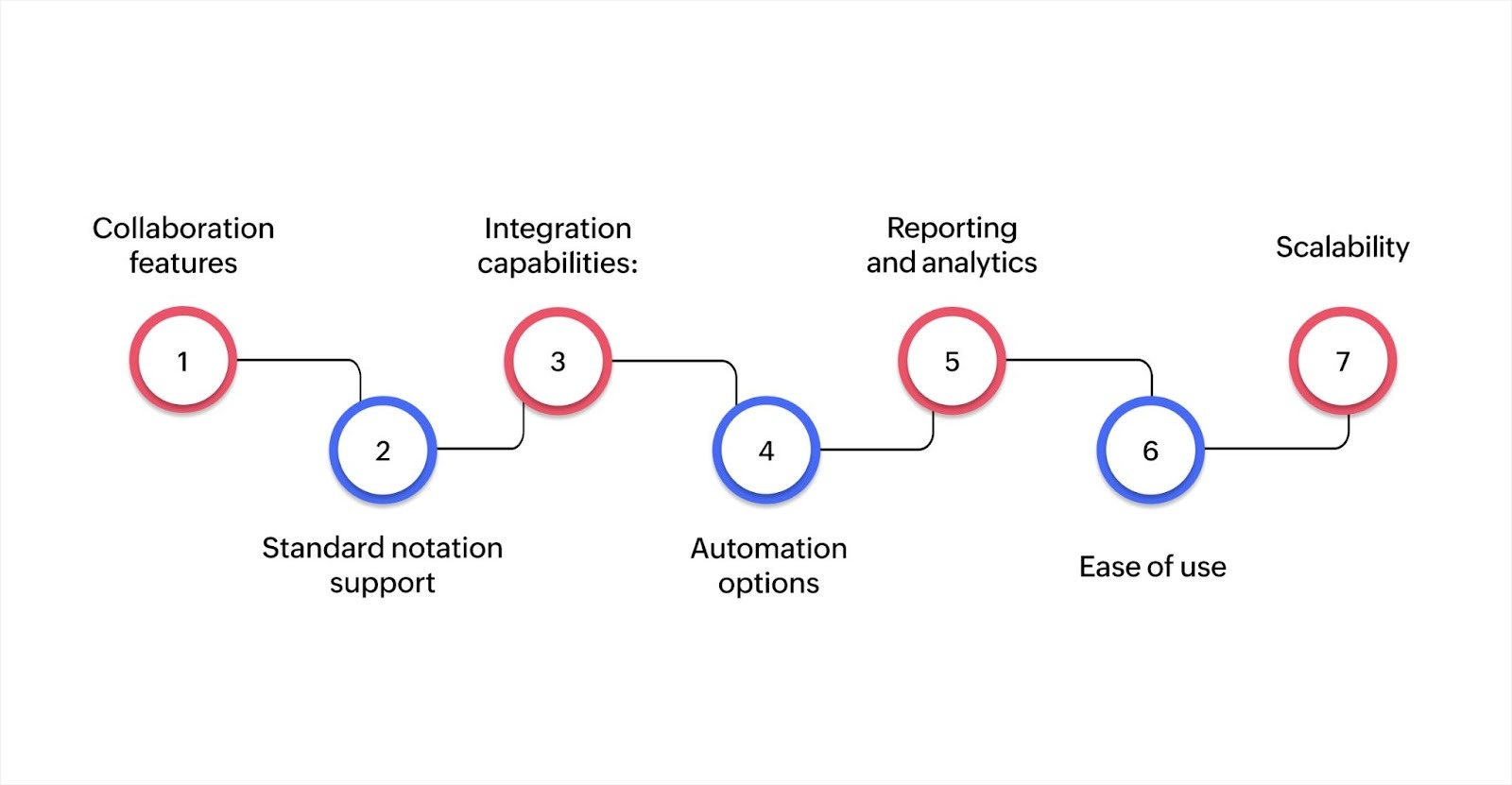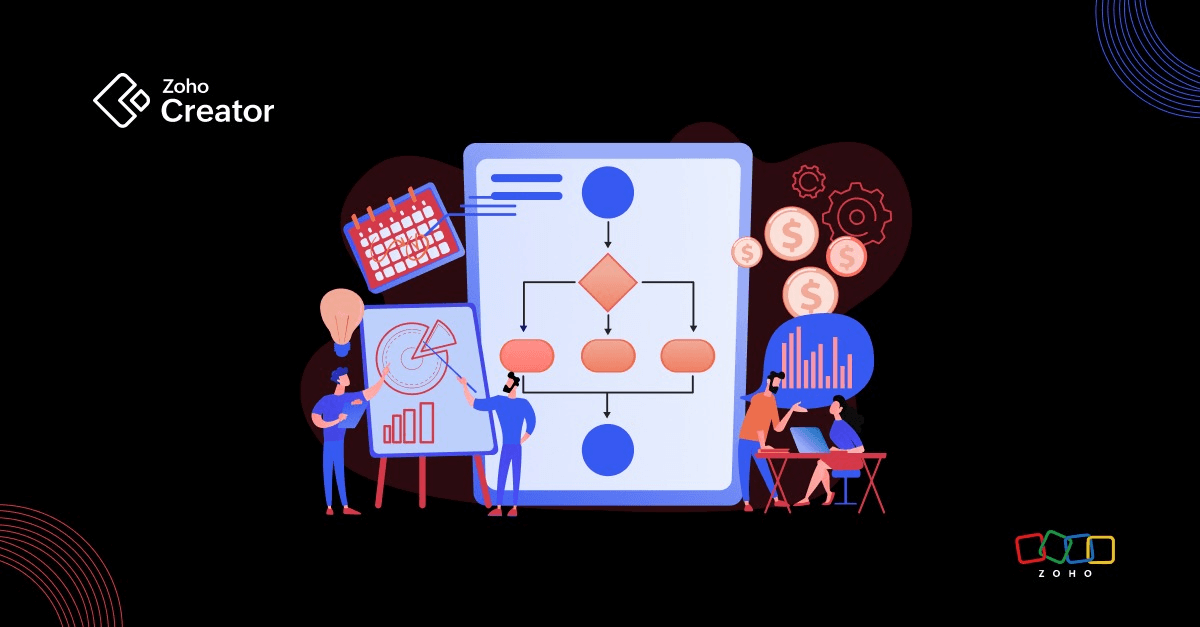- HOME
- Know Your Tech
- Business process modeling tools: Top 10 picks and types
Business process modeling tools: Top 10 picks and types
- Last Updated : October 31, 2025
- 156 Views
- 13 Min Read
Highlights:
- Business process modeling tools are software applications that help you create visual representations of workflows, from simple flowcharts to automated process applications.
- Popular options include Lucidchart, Microsoft Visio, ProcessMaker, and Camunda, each serving different needs and technical skill levels.
- Key features: Look for collaboration capabilities, standard notation support like BPMN, integration options, automation features, and ease of use that matches your team's skills.
- Top benefits: Process modeling gives you better visibility into operations, helps identify bottlenecks, aligns teams, simplifies training, and creates a foundation for automation.
- Common techniques like BPMN, flowcharts, UML diagrams, value stream mapping, and SIPOC diagrams are standard methods for documenting processes, depending on your goals.
Your team is drowning in manual handoffs. Approvals get stuck in email threads. Nobody knows who's responsible for what step in your customer onboarding process. You need a way to see what's actually happening and fix the chaos.
That’s where business process modeling tools can help. These applications let you create visual maps of your workflows so you can spot problems, train new team members, and improve how work gets done.
Organizations across industries are recognizing this value. According to recent data, the business process management sector is set to expand from $20.38 billion in 2024 to $61.17 billion by 2030, representing a 20.3% annual growth rate.
Let’s take a detailed look at what business process modeling tools are, popular options in the market, their key features, and how you can choose the right one for your needs.
What are business process modeling tools?
Business process modeling tools are software applications that help you create visual representations of how work flows through your organization. They let you map out each step in a process, showing who does what, when things happen, and how different tasks connect.
These tools range from simple diagramming applications that create flowcharts to comprehensive platforms that can automate and execute the processes you design.
For instance, a customer support team can use a process modeling tool to map their ticket handling workflow, showing how tickets move from initial contact through resolution. This visual map helps them spot where tickets get delayed or where handoffs create confusion.
The goal is always the same: Make invisible work visible. When you can see a process laid out clearly, you can analyze it, improve it, train people on it, and sometimes automate parts of it.
Different business process modeling tools offer different capabilities depending on whether you need basic documentation or working automation, but they all support standard modeling techniques to visualize workflows. Here are the most common techniques they support:
- BPMN (Business Process Model and Notation): Standardized method using specific symbols for events, activities, gateways, and flows to create detailed process diagrams
- Flowcharts: Simple diagrams with basic shapes like rectangles for actions and diamonds for decisions that are easy for anyone to understand
- UML (Unified Modeling Language): Activity diagrams that show complex workflows with parallel activities and decision logic
- DMN (Decision Model and Notation): Framework for modeling business decisions and rules separate from process flows, often used alongside BPMN
- Value stream mapping: Technique that identifies waste and value-adding steps, showing both information flow and work flow
- SIPOC: High-level overview that outlines suppliers, inputs, process, outputs, and customers before detailed mapping
What are the types of business process modeling tools?
Business process modeling tools range from simple to sophisticated. On one end, you have basic drawing applications. On the other, you have platforms that let you build working applications from your process models.
Here are the main types you'll come across:
| Type | Best for | Complexity | Key capabilities | Example use case |
| Basic diagramming | Simple flowcharts | Low | Visual mapping only | Documenting workflows |
| BPMN-focused | Standardized notation | Medium | Advanced notation and collaboration | Process documentation with standards |
| Process mining | Analyzing existing data | High | Data-driven insights | Understanding actual vs. intended flow |
| Low-code platforms | Building working solutions | Medium-high | Automation, blueprints and app building | Creating process-driven applications |
Knowing about these categories helps you match tools to your needs. Basic diagramming tools work for documentation. BPMN-focused tools suit organizations needing standardized notation. Process mining reveals how work actually flows through systems.
Low-code platforms let you move from models to working automation without extensive coding. With Zoho Creator, you can design workflows visually using blueprints and turn them into custom applications with built-in automation and integrations.
Top 10 business process modeling tools to explore
The market offers various tools, each with different strengths. Here are some of the most popular options compared with their key features and starting price:
| Tool | Best for | Key strength | Starting price |
| Lucidchart | Collaborative diagramming | Real-time collaboration | $9/user/month |
| Microsoft Visio | Microsoft ecosystem users | Office integration | $5/user/month |
| ProcessMaker | Documentation and automation | Workflow execution | $3,000/month |
| Camunda | Developer teams | Open-source flexibility | Free/custom |
| Appian | Enterprise automation | AI and RPA integration | Custom pricing |
| Nintex | Microsoft/Salesforce users | Ecosystem integration | Custom pricing |
| IBM Blueworks Live | Enterprise collaboration | Governance features | $56.20/user/month |
| SAP Signavio | SAP-centric organizations | Process mining and modeling | Custom pricing |
| ARIS | Large enterprises | Enterprise architecture | $145/user/month |
| Zoho Creator | Custom app building | Full application platform | $8/user/month |
Let’s take a detailed look at the top business process modeling software solutions.
1. Lucidchart
Lucidchart is a cloud-based diagramming tool designed for creating professional flowcharts and process maps. The platform emphasizes real-time collaboration, letting multiple team members work on diagrams simultaneously from anywhere.
Key features:
- Real-time collaboration: Multiple users can edit diagrams simultaneously, so distributed teams can map processes together during meetings without version conflicts.
- Extensive template library: Ready-made process flowcharts and BPMN diagrams help teams start quickly without building from scratch.
- Google Workspace and Microsoft Office integrations: Embed live process diagrams in documents and presentations that update automatically when the source changes.
- Drag-and-drop interface: No training is required, making it accessible for business users who need to document workflows without learning complex software.
Best for: Teams needing collaborative, easy-to-use visual diagramming without extensive technical requirements.
Pricing: Individual plans start at $9 per user per month, with team plans at $10 per user per month billed annually.
2. Microsoft Visio
Microsoft Visio is a desktop and web-based diagramming application that integrates with the Microsoft 365 ecosystem. It offers professional diagram creation with extensive shape libraries and data connectivity features.
Key features:
- BPMN 2.0 support: Create standardized process documentation that follows industry notation standards, making diagrams portable and understandable across organizations.
- Office integration: Embed live diagrams in Word documents, PowerPoint presentations, and Teams channels, keeping process documentation connected to your daily work.
- Data linking: Connect diagrams to Excel spreadsheets or databases so your org charts and process maps automatically update when source data changes.
- Desktop and web versions: Get full editing capabilities offline while still enabling cloud collaboration when needed.
Best for: Organizations already using the Microsoft ecosystem who want professional diagramming that integrates with existing Office tools.
Pricing: Web version (Visio Plan 1) starts at $5 per user per month, desktop version (Visio Plan 2) at $15 per user per month, both billed annually.
3. ProcessMaker
ProcessMaker is a low-code business process management platform that combines process modeling with workflow automation. It uses case-based pricing, allowing unlimited processes and users while charging based on running cases.
Key features:
- BPMN 2.0 modeling: Create standardized process maps that can be executed directly as workflows, bridging the gap between documentation and automation.
- Visual form builder: Design custom data collection forms without coding so you can create intake forms and approval requests that match your exact needs.
- Unlimited processes and users: Case-based pricing means you pay only when workflows run, making it economical for organizations with many processes but variable usage.
- Development and production environments: Test process changes safely before deploying them live to your team.
Best for: Organizations wanting to document processes and immediately execute them as automated workflows without rebuilding in separate tools.
Pricing: Standard plan starts at $3,000 per month (includes 1,000 cases), billed annually. Professional and Enterprise plans are available with custom pricing.
4. Camunda
Camunda is an open-source workflow and decision automation platform built for technical teams and developers. It supports BPMN for workflows and DMN for business rules with flexible deployment options.
Key features:
- Open-source flexibility: Customize every aspect of process execution and integrate with any technology stack without vendor lock-in.
- BPMN and DMN support: Combine workflow automation with decision logic so you can model both process flows and business rules in standardized notation.
- REST API: Integrate with any system through standard web protocols, making it easy to connect processes with existing applications and microservices.
- Cloud or self-managed deployment: Host on your infrastructure or use managed cloud services, depending on security and control requirements.
Best for: Technical teams and developers needing scalable process automation with full control over implementation and customization.
Pricing: Free open-source version available. Enterprise cloud plans start at custom pricing with a 30-day free trial, and an Enterprise self-managed plan is also available.
5. Appian
Appian is an enterprise low-code automation platform that combines process modeling with application development, RPA, and AI capabilities. It's suitable for large organizations with complex automation needs.
Key features:
- Low-code development: Visual builders with custom code options let business users and developers collaborate on complex applications together.
- RPA integration: Automate interactions with legacy systems that lack APIs so you can include manual desktop tasks in your automated workflows.
- AI capabilities: Extract data from unstructured documents and assist with process design with document processing and generative AI features.
- Data fabric: Connect multiple data sources into unified views without moving data, enabling processes that span different systems while maintaining a single source of truth.
Best for: Large organizations building enterprise applications that combine process automation, case management, and AI-driven decision making.
Pricing: Standard plans have custom pricing based on users and applications. Contact the vendor for quotes. Enterprise deployment includes a cloud SLA.
6. Nintex
Nintex is a process automation platform with a drag-and-drop workflow builder that integrates well with Microsoft SharePoint, Office 365, and Salesforce ecosystems.
Key features:
- Drag-and-drop workflow builder: Create automated processes visually without scripting, making automation accessible to business users familiar with flowchart concepts.
- SharePoint and Office 365 integration: Automate document approvals, content management, and collaboration workflows directly within tools your team already uses daily.
- Document generation: Create contracts, reports, and forms automatically from workflow data, reducing manual document assembly time and formatting errors.
- Mobile forms: Let field teams submit data and complete tasks from phones or tablets, keeping workflows moving even when workers aren't at desks.
Best for: Organizations using Microsoft or Salesforce platforms who want to automate workflows within those existing environments.
Pricing: Contact vendor for pricing. Plans are based on features and scale, typically starting around custom monthly fees for workflow automation capabilities.
7. IBM Blueworks Live
IBM Blueworks Live is a cloud-based collaborative process modeling tool focused on business process discovery and documentation. It emphasizes team collaboration with a simple, no-training-required interface.
Key features:
- Simple collaboration tools: Multiple stakeholders can contribute to process maps through comments and approvals without complex training or technical skills.
- BPMN 2.0 support: Create standardized process documentation that can be exported to execution platforms when you're ready to automate.
- Milestone tracking: Monitor process improvement initiatives, showing which process changes are in draft, review, or published stages.
- Central repository: Store all process documentation in one secure location, making it easy to find, reference, and maintain organizational process knowledge.
Best for: Enterprise teams needing collaborative process documentation with governance, version control, and central repository capabilities.
Pricing: Editor plans start at $56.20 per user per month. Adding Contributors starts at $11.25 per user per month, and Viewer packs (100 users) start at $225. There's a 30-day free trial available.
8. SAP Signavio Process Manager
SAP Signavio Process Manager combines process intelligence and modeling, using process mining to discover, document, and improve actual workflows from system data.
Key features:
- Process mining: Analyze data from SAP and other systems to automatically discover how work actually flows, revealing gaps between documented and actual processes.
- BPMN modeling: Create standardized process documentation that can be compared against mined processes to identify improvement opportunities.
- SAP integration: Connect directly to SAP systems for seamless data flow and process execution within your existing SAP environment.
- Collaboration features: Enable process owners across departments to work together on process documentation and improvement initiatives.
Best for: SAP-centric organizations with complex processes that need both process discovery from existing data and traditional modeling capabilities.
Pricing: Contact SAP for custom pricing based on organizational size and requirements. There's a 30-day free trial available.
9. ARIS
ARIS is an enterprise architecture and process modeling platform designed for large organizations managing complex processes across multiple business units and geographies.
Key features:
- Multiple modeling notations: Support BPMN, EPC, UML, and other methods, letting different departments use familiar frameworks while maintaining a central repository.
- Enterprise architecture management: Connect process models to IT systems, organizational structures, and data models for complete business context.
- Governance tools: Enforce naming conventions, approval workflows, and access controls to maintain consistency across thousands of process models.
- Process mining and analysis: Discover actual workflows from system logs and compare them against documented standards.
Best for: Large enterprises needing comprehensive process management across business units with strict governance and multiple modeling notations.
Pricing: The Basic edition starts at €125 ($145) per user per month (1–20 users), and the Advanced edition starts at €250 ($290) per user per month (plus a base fee). The Enterprise edition has custom pricing.
10. Zoho Creator
While the tools above focus primarily on process documentation and modeling, some platforms offer broader capabilities. Zoho Creator is an AI-powered low-code application development platform that combines visual workflow design with full application building capabilities.
Key features:
- Visual workflow builder: Design approval processes, task routing, and notifications with drag-and-drop simplicity, letting business users automate workflows without writing code.
- Custom application development: Create complete business apps around your processes, including forms, databases, reports, and dashboards that work together seamlessly.
- 1000+ integrations: Connect your processes to Google Workspace, Microsoft 365, Salesforce, Slack, and hundreds of other tools your team already uses daily.
- Mobile-ready apps: Work automatically on phones and tablets without separate mobile development, keeping field teams and remote workers connected to your processes.
- Process blueprints: Map and enforce every stage of your business processes visually—from initiation to completion—using blueprints that define roles, transitions, and approval conditions.
Best for: Teams that want to move beyond static diagrams to build custom process-driven applications without extensive coding or technical resources.
Pricing: The Standard plan starts at $8 per user per month, the Professional at $20 per user per month, and the Enterprise at $25 per user per month, all billed annually. Free edition is available with one app. There's a 15-day free trial. Learn more about Zoho Creator's pricing.
Each of these tools serves different needs and budgets. Your choice should align with your technical capabilities, team size, and whether you need just documentation or full automation capabilities.
Why use business process modeling tools?
Mapping your processes visually creates clarity that text documents and verbal explanations can't match. When everyone can see the same picture of how work should flow, teams align faster and execute more consistently.
In fact, data shows that companies using business process management solutions can see productivity gains of 50%, sales improvements of 20%, and revenue increases reaching 40%.
Here's how process modeling tools can help you:
- Better visibility: See how work actually flows through your organization instead of guessing or relying on tribal knowledge.
- Identify bottlenecks: Spot where processes slow down, handoffs fail, or work piles up waiting for approvals.
- Team alignment: Get everyone on the same page about responsibilities, sequence, and decision points in critical workflows.
- Easier training: New team members can learn processes visually rather than piecing together information from multiple sources.
- Process improvement: Document your current state clearly so you can design and communicate better in the future.
- Automation foundation: Clear process models become blueprints for workflow automation, showing exactly what to build.
How to choose the right business process modeling tool

Choosing a process modeling tool means evaluating capabilities against your specific needs. Focus on these key capabilities while selecting the best tool for your needs:
- Collaboration features: Multiple users should be able to work on process models together, comment, suggest changes, and track versions without stepping on each other's work.
- Standard notation support: Look for tools that support BPMN, flowcharts, and other recognized methods so your documentation remains portable and understandable.
- Integration capabilities: The tool should connect with your existing systems, like CRM, ERP, or databases, to avoid creating disconnected process documentation.
- Automation options: If you plan to automate processes eventually, choose a tool that supports turning models into working workflows rather than just static diagrams.
- Reporting and analytics: Track how processes actually perform with metrics, identify improvement opportunities, and demonstrate the value of process changes.
- Ease of use: An intuitive interface matters more than feature lists if your team won't use a complex tool consistently.
- Scalability: The tool should grow with your needs, from simple diagrams to complex automation, without forcing you to switch platforms later.
Consider which features you need now versus which you'll need as you mature your process management practice. Starting with a platform that supports growth often costs less than migrating tools later.
Build process-driven applications with Zoho Creator
Process modeling is important, but the real value comes when you can turn those models into working applications. Documentation alone doesn't change how work gets done. You need execution.
Zoho Creator is an AI-powered low-code app development platform that lets you design, build, and automate business processes without extensive coding. You can model workflows visually and immediately turn them into functional applications with forms, automation, integrations, and analytics.
Here's how Zoho Creator helps you go beyond basic process modeling.
- Business process automation: Set up multi-step approval workflows, task assignments, and escalations that run automatically based on your business rules and timelines.
- Data integration and unified data model: Connect data from multiple sources into a single view so your process applications can access information from CRM, ERP, and databases without manual data entry.
- Custom portals for stakeholders: Create branded portals where customers, vendors, or partners can submit requests, track statuses, and interact with your processes securely.
- AI-powered app building: Generate forms, workflows, and reports using natural language descriptions, cutting development time while maintaining full customization control.
- Analytics and reporting: Track process performance with real-time dashboards, identify bottlenecks with visual reports, and make data-driven improvements to your workflows.
From documenting a simple approval flow to building a complete operations management system, Zoho Creator gives you tools to model, automate, and continuously improve your business processes. Sign up for free and start building today.
FAQ
1. Do I need technical skills to use business process modeling tools?
Basic diagramming tools require no technical skills, just an understanding of your process. More advanced tools with automation capabilities need some technical knowledge, though many low-code platforms now offer intuitive visual builders that anyone can use.
2. Can business process modeling tools integrate with my existing software?
Most modern process modeling platforms offer integrations through APIs or built-in connectors. Check that any tool you choose can connect with your critical systems, like CRM, ERP, or databases, to avoid creating disconnected processes.
3. How much do business process modeling tools typically cost?
Costs vary widely from free open-source tools to enterprise platforms costing thousands monthly. Simple diagramming tools are often free or under $15 per user monthly, while comprehensive automation platforms typically start around $25 to $50 per user, with volume pricing available.
4. What is the best modeling technique for process improvement projects?
Value stream mapping works well for identifying waste and improvement opportunities. BPMN is excellent for documenting detailed processes before and after improvements. Choose based on your specific goal, whether that's high-level analysis or detailed documentation.
5. Should I choose a standalone tool or a platform with broader capabilities?
If you only need occasional process documentation, a standalone diagramming tool works fine. If you're planning to automate processes or build applications around them, it’s best to choose a platform that offers modeling, automation, and development capabilities in a single solution to avoid switching between multiple tools.
 Ann Elizabeth Sam
Ann Elizabeth SamHey! I'm Ann, and I work as a content writer at Zoho Creator. I'm exploring the SaaS world through various forms of content creation. Outside of work, I love dancing and would give up anything to read a good murder mystery.



